SOA for Business Technology – SOA and Business Architecture
Introduction
SOA is integral to the formulation of SOEs, organizations whose business models are aligned on capabilities and service-based models, as opposed to traditional organizational silos. SOEs possess fundamental attributes such as flexibility, agility, consistency of data quality, cost efficiency, and adaptability that modern organizations require. This includes the ability to use emerging technologies such as the cloud and Internet of Things (IoT) seamlessly. In particular, in such organizations, operation is based in terms of business services. To be able to understand SOA4BT, we need to take the model for business and technology and the role of SOA further.
Business Architecture establishes a context around what the organization does and how it does it. For an organization to become an SOE, there needs to be the ability to align the business along business services and have a business strategy and model to align the business and the underlying SOA. SOEs think in terms of capabilities and services. They are able to measure, adapt, and apply SOA and operate in a service-oriented manner.
As organizations become service-oriented, the process involves enterprise and operational aspects. It normally evolves from establishing a capability-based business model aligned with an SOA, evolving to a business expressed in terms of business services – in short, an SOE. This involves the process of alignment and business modeling in a service-oriented context, the establishment of a metrics model that allows measurement of business goals in terms of services, and the realization of the alignment and establishment of the SOE.
In this section we define a model for the Business Architecture for such an enterprise, and how it translates an organization from traditional silos to an SOE. We also describe how an SOE’s business is translated into the implementation of an SOA.
The Pillars of Alignment of Business and SOA
Business and technology enablement and alignment occur along three pillars: Strategic, Operational, and Operating Model.
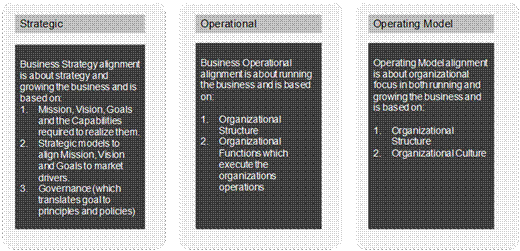
Pillars of Alignment
Strategic Pillar
The Strategic Pillar addresses organizational strategy, orienting the organization around the organizational mission, vision, and goal, which can then be mapped to:
- Capabilities for aligning technology and business strategy and delivery
- Alignment along business strategic models such as Porter’s five forces analysis
- Governance, by deriving goals, principles, and policies
Operational Pillar
The Operational Pillar addresses how an organization executes, which includes:
- Organizational structure
- Organizational function which is the expressing of the operation in terms of large processes
- Alignment of the functional operation of the enterprise in terms of business processes and business services
Operational alignment addresses how an organization runs itself. It answers questions such as: “What are the operations (functions) that address how an organization runs?”, “What are the business processes and business services around which these operations are structured?”, and “How does the organization structure support its operations?”.
Operating Model Pillar
The Operating Model Pillar addresses the manner in which an organization is run. It includes:
- Fiscal models
- Cultural structure
Operating model alignment addresses questions such as: “How does the organization structure itself?”, “How does that structure support sharing?”, “How are business executives, and in effect organizational units, measured for success?”. The last question is very different from how the organization itself measures success, and focuses more on the effective organizational culture. If business unit executives are measured by individual and business unit success as opposed to organizational success – effectively potentially competing against each other – the inclination towards a shared services model is much lower.
The operating model impacts the effective adoption of SOA and the organization’s adoption of business services, and its successful transition becoming an SOE, because the operating model influences funding, focus, and the appetite and ability to share resources and services. Operating models can have significant impact on organizational efficiency and effectiveness in the context of SOA, because fiscal governance and decision rights are impacted by the operating model’s service-oriented context. When we further extend this to consider that organizations that become service-based inherently show greater agility and reuse, then the kind of operating model becomes more important.
Once taken in that context, we can see that:
- Strategic business alignment is brought about through the use of capabilities which act as the point of integration between SOA and the business.
- Operational execution of the business is aligned along the business processes which form the point of alignment, where business “hows” translate to SOA “dos”.
- Operating models form the alignment for determining structural funding and operational decision rights, feeding to governance frameworks.
- Business strategy maps through goals, principles, and policies to actionable SOA governance.
Strategy Realization
This section describes the realization of pillar 1 (strategy), from business strategy to IT capabilities.
Business Strategy
Business strategy is enabled by business capabilities, which are enabled by IT capabilities. These IT capabilities form the basis on which the industry SOA models are further filtered to form a particular organization’s SOA.
For example, a hospital health system may want to be able to view the impact of a treatment of a group of patients in a particular demographic distribution. In order to do this there needs to be the ability to view information from multiple patient data sources in a de-identified manner. The SOA now needs to have the ability to provide services that can easily compose this data from different sources, and its security and quality of service layers need to provide the ability to support de-identification. This ability to express organizational strategy in terms of business capabilities that are in turn realized by IT capabilities is an integral part of the relationship between SOA and business strategy. While the business may not need to understand the details of how this works, the ability to clearly show how the business capabilities are being realized in a quantified manner is one of the success factors in the effective use of SOA.
The following figure shows the relationship between business strategy and the technology elements in an SOA in an SOE.
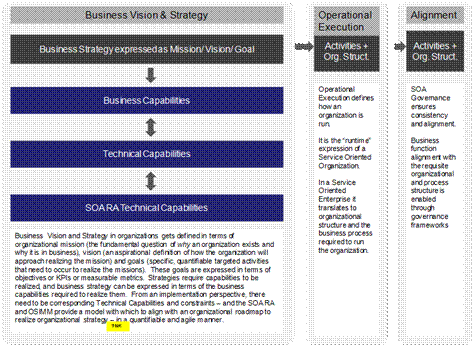
Business Strategy and Technology Elements
Capabilities
Capabilities are the granular elements that define what organizations can do. Capabilities, accompanied by business processes, provide an agile and flexible mechanism to define business and technical elements which are focused on how the business executes and are organizational unit-agnostic. Changes in the organizational structure do not normally impact a capability. Thus capability maps form a good basis for the creation of resilient roadmaps.
Capability maps (collections of capabilities hierarchically grouped) can easily then form the basis for organizational portfolios of programs or projects that help realize roadmaps. These roadmaps form the manner in which services are rolled out. Co-relation between services translates into service categories. Service categories have significance in terms of governance and skill-set and so form a key aspect of realizing the enterprise portfolio.
Capabilities and their alignment with the realized SOA provide other significant advantages – in particular agility and impact assessment. Dropping a capability has direct business and IT impact. This allows immediate visibility and agile changes in architectural and SOA direction.
Operation Realization
This section describes the realization of pillar 2 (operational), from business function to business process.
The Operational Model of an organization combines organizational structure and business functions as required to “run-the-business”. How an organization runs is expressed in terms of business functions.
A business function is an organizational perspective on behavior. It is not the same as a business capability. A business function defines the “what” behavior that is associated with an organizational unit and modeled in a target operating model. A business function is typically named with a suffix of “management” (e.g., “Customer Relationship Management”), but could also be a single noun (e.g., “Billing”). Business functions can be decomposed into component business functions, resulting in a business function hierarchy.
Business functions can also be decomposed into business processes or service compositions. This is the point where the business execution aspects of service-orientation map to the solution SOA. In the case of an SOE, business functions and business processes are orchestrations of business services. Business services are operational entities which may have a technical manifestation.
For example, a business function may be Provider Reimbursement, and decomposed functions may be Incentive-based Reimbursement Management and Payer Deal Negotiation. The business processes associated with Incentive-based Reimbursement Management could be Conduct Patient Satisfaction Survey and Prepare Payer Risk Pool by Outcome. The triggered SOA services for the business process Conduct Patient Satisfaction Survey may invoke the Validate Patient Information, Update Survey Information, and Update STAR Scores services. Reuse, data quality improvement, and agility improvement are obvious from this example – for example, the Validate Patient Information service could be reused in numerous scenarios.
The following figure illustrates the mapping of the operational pillar of an enterprise to an SOA.
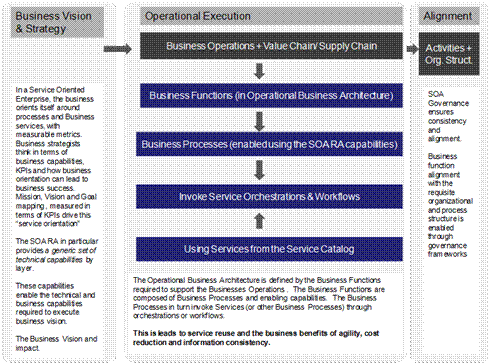
Operational Pillar Mapping to SOA
Operating Models
This section describes the realization of pillar 3 (operating model).
Operating models determine how a business operates in terms of its culture and its fiscal funding model. This impacts how funding is provided for SOA, how fast organizations transition from legacy application-centric models, and the extent of impact of SOA adoption on an organization. Without a proper understanding and incorporation of the operating model into IT strategy and Business Architecture specification there is the likelihood of trying to fit a square peg into a round hole, and a lack alignment.
People are a critical part of any business, and the way in which an organization manages funds, interacts, and is structured is impacted by this operating model. SOA, through its governance models, allows for alignment with organizational operating models.
Implications
There are three implications of organizational operating models in the context of Business Technology and SOA:
- In the context of an organization which is relatively early in its SOA adoption (i.e., SOA is considered more from a technology perspective rather than a business perspective), the operational model defines organizational unit focus.
- Operating models drive executive championing of organizational adoption of service-orientation as a business.
- Operating models determine fiscal commitment towards SOA – both at a business and technology level.
From an implementation perspective, this translates into governance and organizational structure.
Understanding Operating Models
The term operating model is defined in Generating Business Value from Information Technology (Ross) as: “The desired level of business process integration and business process standardization for delivering goods and services to customers.”. It defines how a firm will profit and grow. From an SOA perspective, it determines funding models, organizational structure, culture, and the efficacy of shared services. Operating models typically get grouped into four categories based on how organizational units relate to each other. Organizations may fall into these groups based on the structure and prioritization of executive management – thus defining organizational culture and focus.
The four types of operating models are coordination, unification, diversification, and replication.
Coordination Models
Coordination models occur where unique business units exist, but need to understand each others’ transactions. Good examples may be insurance companies such as MetLife. The operating model promotes the sharing of some aspects of business value chains, shared services, and shared data. In such an operating model, executive management is effectively typically making a conscious decision to keep organizational business units separate, but share information. From a technology perspective, this leads to a robust shared services model to support the loose organizational coupling and a focus on factors such as data quality. Trusting the shared information is critical for success of such a model.
Unification Models
Unification models occur where there is a single, central, global organizational view and all business units are structured around it. Delta Airlines is a good example of this. In a unification scenario organizational value chains are structured around this unified view. This model supports rationalization and unification of shared value chain processes, and shared services.
Diversification Models
Diversification models occur where you have independent business units with different customers and expertise. Examples include the McGraw Hill companies (prior to their division into McGraw Hill Financial and McGraw Hill Education) and GE. Holding companies with disparate subsidiaries doing different kinds of business are a good example. In a diversification scenario, from a business service perspective there are few value chain processes to share, though supply chain processes may be shared. From a technology perspective, an organizational sharing of infrastructure services and platforms is usually feasible.
Replication Models
Replication models occur where there are independent but similar business units. In such organizations, executive management often encourages competition between organizational units in terms of some clearly defined KPIs, typically centered on shared value chain processes. Due to this internal competition between organizational units, value chain sharing is disincentivized, with business unit leaders trying to develop and run their own implementations and variations. The value proposition behind SOA4BT in this context centers on the creation of effective shared processes, and the isolation and identification of the explicit value proposition on which the business units compete and the KPIs associated with them. This allows for maximum organizational agility and cost reduction. Examples include Marriott, ING, etc.
Operating Models and SOA
The following figure illustrates operating model types and their implication from an SOA perspective.
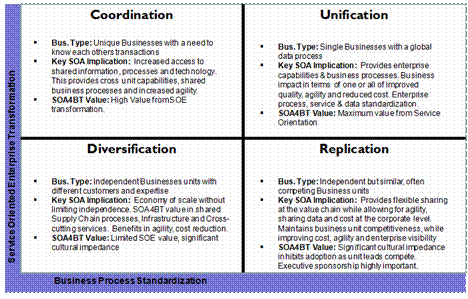
Operating Models and Business Process
The operating model directly correlates with organizational support for business processes and in particular for business process standardization and integration. The reasons are obvious – operating models reflect organizational focus – and if the operating model does not support a shared service model, there is a fundamental gap in terms of organizational readiness for business process integration and standardization. Business executives engaged in adopting an SOE model should incorporate this into their assessment. IT executives and enterprise architects when adopting SOA should also factor this in. Unification involves the greatest integration and standardization.
Operating Models and Business/IT Culture
Operating models should also be factored in when considering organizational cultural readiness for service-orientation. Service-orientation is not solely about technology adoption – it is as much about business change. Business adoption is occurring because businesses get more agile and efficient.
Operating models are a good indicator of cultural readiness for SOA adoption. If the organization’s basic structure does not support sharing and alignment, then the extent of adoption of service-orientation gets impacted.
Enterprise Adoption of SOA
Service-orientation in a business context implies organizational orientation in a service-based model. This can be expressed in terms of business process, capabilities, and services (most business strategies factor that in). Business process integration thus becomes a measure of the level of reuse and successful adoption of service-orientation. This also has a direct impact on IT service-orientation – the “how” of service-orientation implementation. This includes business services and service categorization and shared service models. All these factors need to be aligned and factored in when defining an enterprise’s adoption of SOA.
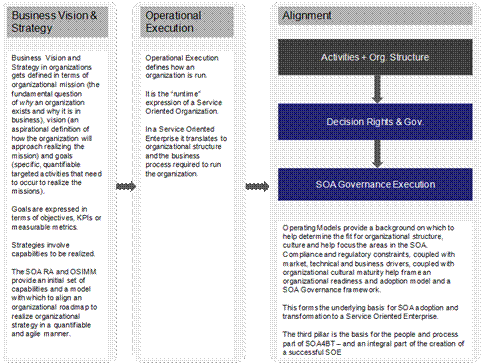
Enterprise Adoption of SOA
Thus operating models play an important part in defining the fit for organizational adoption of service-orientation. They help determine how much of a fit exists, how it can be applied, and what kinds of cultural barriers may exist. It also helps determine the level of governance – and the extent to which it can be applied. Finally it helps focus an organization’s roadmap towards service-orientation, as well as where and what aspects of the technical architecture need to be focused on. For example, an organization fitting a unified model would be very good for a core business service model, with business units organizing against shared services and business processes. In that scenario, service-orientation brings great value – speed to market, cost, data consistency, etc. However, in a scenario where an organization has a diversification model the organization does not fit service-orientation very well, and the only aspects that might be service-oriented may be infrastructure services in the operational systems layer, with business services not being a total fit.
Metrics
This section describes the use of metrics for aligning business and SOA on measurement and governance.
The quantification of the outcomes of SOA to organizational delivery is important in order to have long-term sustained adoption of SOA, and in rolling out an SOA roadmap, as well as to the migration of an enterprise to an SOE or business. This aspect helps us answer the questions: “How does the business evaluate the impact of SOA and how do we track success?”. As shown in the following figure, organizational metrics (balanced scorecards, etc.) can be used to define and determine SOA governance, in particular policies and architectural decisions.
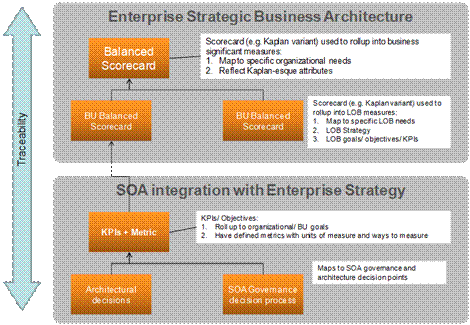
Organizations typically align on capabilities and functionality. Industry standard measures drive success measurement (in non-trivially sized organizations). Typically, some flavor of a balanced scorecard (e.g., Kaplan scorecard) tailored to meet the organization’s line of business drivers is created; that is, what the board and executive measure by and organizational performance is typically assessed. Service-orientation – both from a business level, as well as from a technology level – can be thought of as a style. In the context of architecture, The Open Group defines it as an architectural style. The biggest struggle has been to align IT initiatives to business goals. However, service-orientation by its nature supports that very alignment. KPIs and metrics are easily captured for services – and a good SOA governance framework supports easy mapping of those KPIs to the business KPIs. This capability is a key feature of the service-oriented style.
Furthermore, the technology capabilities of SOA support this. Why is it important from an SOA4BT perspective? It is important because SOA4BT is the point of alignment between SOA and business. Business services provide the linkage – we can capture metrics for business processes and business services, and a well-designed SOA governance framework aligns these to business metrics in alignment with service-orientation.
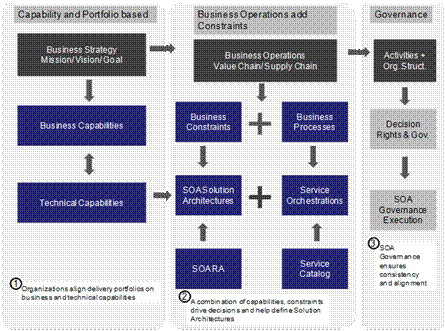
Alignment through SOA Governance